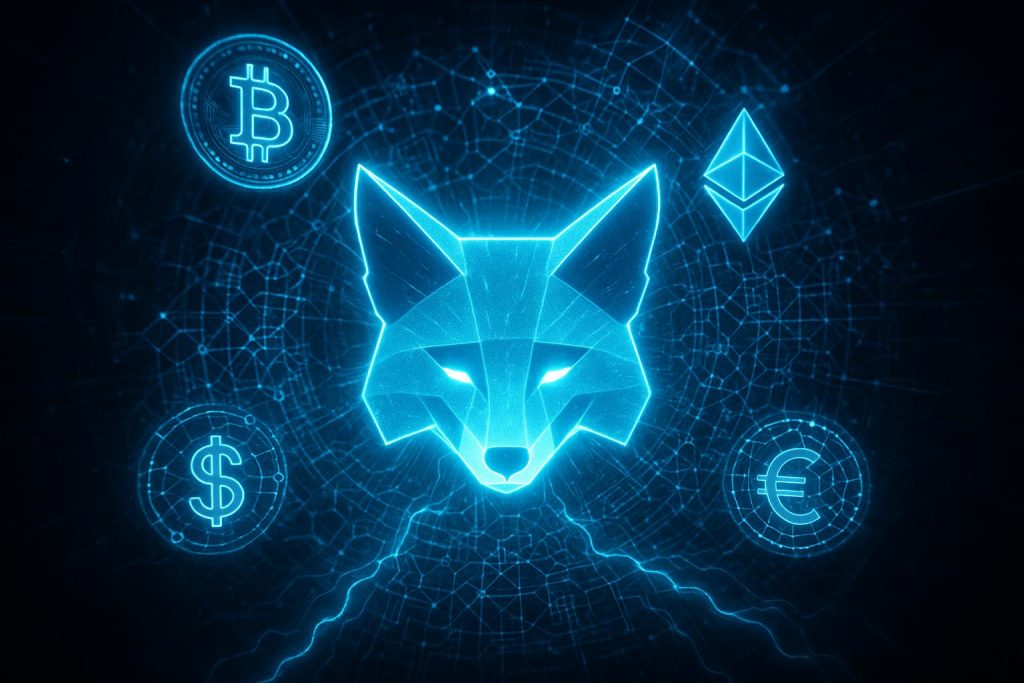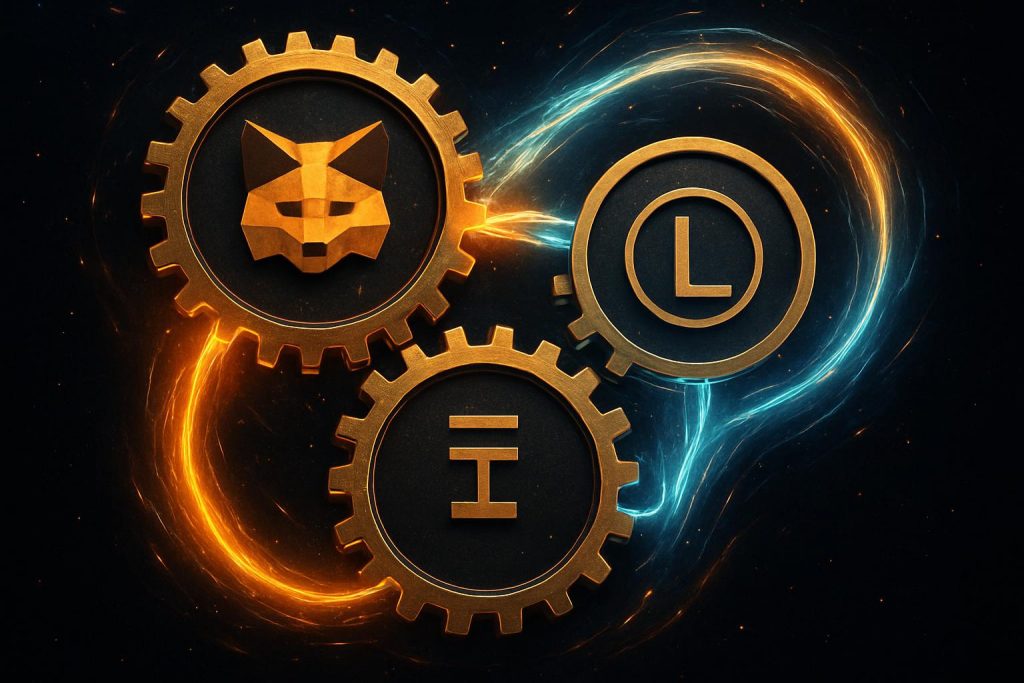The Fox Unchained: Analyzing the MetaMask Token and the Dawn of the Wallet Economy

I. The Announcement: A Market-Moving Confirmation
For years, it was the crypto market’s most persistent rumor. Then, in a single podcast appearance in mid-September 2025, the rumor became reality. ConsenSys CEO and Ethereum co-founder Joseph Lubin, speaking on The Block’s “The Crypto Beat” podcast, delivered the definitive confirmation that sent a shockwave through the digital asset ecosystem: the MetaMask token is coming.
Lubin’s statement was unequivocal. “The MASK token is coming,” he declared, a statement quickly reported by ForkLog, immediately transforming the long-speculated asset into a concrete, near-term event. To amplify the message, he added a deliberate note of imminence, stating the launch “may come sooner than you would expect right now.” This carefully chosen language was a clear signal to the market, preparing users and investors for a potential release in the fourth quarter of 2025, a timeline that analysts, as covered by KuCoin, quickly began to forecast.
Crucially, Lubin framed the token’s purpose not as a speculative instrument but as a strategic tool integral to the company’s core philosophy. The launch, he explained, is “significantly related to the decentralization of certain aspects of the MetaMask platform,” a strategic framing noted by industry observers. This narrative positions the token as a vehicle for community ownership, aligning with the foundational ethos of the Ethereum ecosystem. The reaction was electric. The news dominated crypto discourse, instantly setting expectations for what many believe could be “the biggest airdrop in history,” a distribution aimed at rewarding MetaMask’s colossal user base.
The timing was a calculated strategic maneuver. This move capitalizes on a confluence of four critical factors. First, the broader crypto market was showing renewed signs of life, with what Lubin himself described as the return of “animal spirits,” providing a favorable tailwind. Second, ConsenSys had just completed a successful token generation event for its Layer 2 network, Linea, providing a fresh operational template for a massive distribution, a strategic connection detailed by Bankless. Third, the company had recently secured a landmark legal victory with the dismissal of a U.S. Securities and Exchange Commission (SEC) lawsuit, removing a significant regulatory overhang. Finally, the competitive pressure from rival wallets, particularly Rabby Wallet’s own token teasers, necessitated a decisive move to reassert market dominance, a dynamic analyzed by ChainCatcher.
Furthermore, the specific phrasing—“decentralization of certain aspects”—is a masterstroke of strategic ambiguity. While MetaMask is a self-custodial wallet, its operations rely on significant centralized infrastructure, most notably the ConsenSys-owned Infura and a revenue model built on its 0.875% swap fee detailed by CoinGecko. Complete decentralization could jeopardize these vital revenue streams. By qualifying the scope, ConsenSys can cede control over areas like treasury grants while retaining authority over core, profit-generating functions. It’s a balancing act that signals a new maturity in the tokenization strategies of major crypto-native firms.
II. The Long Road to $MASK: A History of Speculation and Strategy
The confirmation of the MetaMask token was not the beginning of a story, but the climax of one unfolding for over four years. The journey reveals a patient and calculated strategy by ConsenSys, shaped by technology, community expectation, and a shifting regulatory landscape.
The genesis of the idea can be traced to at least 2021. It was then that Erik Marks, a MetaMask engineer, first publicly floated the concept of instilling “community ownership” through a native token, according to reporting from The Block. This initial proposal established the token as a long-term strategic consideration. The idea gained traction, but it was a cryptic tweet from Joseph Lubin in 2021 that truly ignited the market’s imagination. His simple post—“Wen $MASK?”—transformed an internal concept into a public obsession, setting a powerful expectation that would persist for years.
Despite this tease, the official stance from ConsenSys remained deliberately ambiguous. As recently as May 2025, MetaMask co-founder Dan Finlay described the token launch as still being a “maybe.” Yet, even in his reticence, Finlay provided crucial insights. He outlined a plan to announce any potential token launch exclusively from within the wallet’s interface, a novel approach designed to circumvent the rampant phishing scams that plague airdrop events, a strategy noted by Blocmates.

This prolonged ambiguity was a strategic waiting game dictated by immense regulatory risk. The years between 2021 and 2024 were defined by the SEC’s aggressive “regulation-by-enforcement” campaign, which created a hostile environment for new token launches, a trend analyzed in-depth by firms like KPMG. Launching a token for a platform serving over 30 million monthly users would have been an invitation for severe legal challenges. Finlay himself later acknowledged this, explicitly citing a “more relaxed regulatory climate” in 2025 as a key factor that made a token issuance more feasible, a point reported by CoinCentral.
Throughout this period, the community unofficially christened the token “$MASK.” This ticker, however, already belongs to the unrelated Mask Network project, a point of persistent confusion that ConsenSys has yet to clarify, as detailed in guides from 99Bitcoins. This ambiguity has created fertile ground for scammers, forcing the MetaMask team to issue repeated warnings against fake airdrop claims.
The strategy of an in-wallet-only announcement represents a significant innovation. Airdrops are notoriously fraught with risk, as malicious actors create fake websites to lure users into signing malicious transactions, a common threat outlined by TradeDog. By leveraging its most secure channel—the wallet itself—MetaMask can effectively neutralize this primary attack vector. This approach does more than protect users; it forces millions to actively engage with the wallet, transforming a security protocol into a potent mechanism for user acquisition and ecosystem immersion.
III. Deconstructing the ConsenSys Flywheel: Beyond a Simple Wallet Token
To view the upcoming MetaMask token in isolation is to miss its true significance. It is the linchpin in a meticulously constructed, multi-product ecosystem—a “flywheel” designed by ConsenSys to create a self-reinforcing cycle of growth. Joseph Lubin himself laid out the blueprint, identifying MetaMask, Infura, and the Layer 2 network Linea as the three pillars of the company’s “progressive decentralization” strategy.
At the heart of this strategy lies MetaMask, the undisputed distribution engine. With a staggering user base of over 30 million monthly active users, it serves as the primary gateway to Web3 for a vast segment of the market, a figure often cited in market analysis. This scale provides an unparalleled launchpad for any new ConsenSys initiative.
The second critical component is Linea, the on-chain arena. As a zkEVM Layer 2 network, Linea is engineered to offer the scalability and low transaction costs necessary for mass adoption, something unachievable on the more expensive Ethereum mainnet, as explained in breakdowns of the ConsenSys ecosystem. Linea is deeply integrated into the MetaMask wallet, with dedicated pages to showcase its ecosystem. The recent launch of the LINEA token served as a crucial dress rehearsal. In that distribution, ConsenSys retained a modest 15% of the supply, allocating the vast majority—85%—to builders and community incentives, a model that advances Ethereum’s mission.

The final piece is MetaMask USD (mUSD), the native currency. Launched in August 2025 in a strategic partnership with Bridge (a subsidiary of Stripe) and the M0 protocol, mUSD is a fully-backed stablecoin designed to be the lifeblood of the ConsenSys economy, according to the official announcement. It is already live on Ethereum and Linea, where it quickly amassed a market cap exceeding $53 million, demonstrating strong initial uptake. Its purpose is to create a seamless financial experience, from fiat on-ramps to in-wallet swaps and real-world spending through the forthcoming MetaMask Card, a partnership with Mastercard.
The MetaMask token is the force designed to bind these pillars together. Its primary, unstated function is to solve the adoption problem for Linea. Layer 2 networks are locked in a fierce battle for liquidity, and an airdrop is the industry’s standard weapon. While the LINEA token provided an initial boost, sustaining that momentum is a far greater challenge, a key dynamic in the ongoing Web3 wallet wars. By making interaction with Linea a heavily weighted criterion for the airdrop, ConsenSys can direct a significant portion of its 30 million users to its nascent L2.
Simultaneously, the token and mUSD aim to create a closed-loop financial system, reducing dependence on external stablecoins. By introducing mUSD, ConsenSys can capture value from stablecoin usage and integrate it more deeply into its product suite. The MetaMask token will be the tool to incentivize this shift. Governance could be used to vote on proposals that offer lower swap fees for mUSD pairs, or staking the token could yield rewards paid out in mUSD. This powerful feedback loop is designed to capture both the user and their capital, locking them into a cohesive ConsenSys ecosystem.
IV. The Anatomy of a Wallet Token: Projecting the Utility of $MASK
With the strategic rationale established, the critical question becomes one of function: what will the MetaMask token do? Based on executive statements and industry precedent, a clear picture emerges. It is expected to be a multi-faceted asset built on three core pillars: decentralized governance, direct user incentives, and deep ecosystem integration, as outlined by CryptoNinjas.
The most heavily emphasized utility is governance. The token’s primary purpose, according to Joseph Lubin, is to facilitate the “progressive decentralization” of the MetaMask platform. This implies that token holders will be granted voting rights on platform upgrades, new features, and the allocation of a community treasury. This model follows the template of DeFi blue-chips like Uniswap, where the UNI token grants holders control over key protocol parameters, a common function of governance tokens explained by OSL.
The second pillar is a robust system of user rewards. Widespread speculation suggests the token will be used to reward activity within the wallet, transforming users into active stakeholders. The most obvious application would be a reduction in the 0.875% fee charged by the native MetaMask Swaps feature, a significant revenue generator for ConsenSys, as detailed in CoinGecko’s airdrop guide. A likely model would involve tiered discounts for users who hold or stake the token. Additional incentives could include staking rewards and access to exclusive features, as speculated in OKX’s token launch overview.
For a clear precedent, one need only look to MetaMask’s competitors. Trust Wallet, with its TWT token, provides a direct model. The utility of TWT is extensive, encompassing fee discounts, gas fee payments, premium support, and a loyalty program, all detailed in the TWT litepaper. Trust Wallet’s roadmap explicitly connects TWT to advanced trading features and early access to new projects through its “Trust Alpha” program, part of its bold plan to onboard the next billion users. It is highly probable that ConsenSys will implement a similarly comprehensive suite of utilities.
However, implementation will be a delicate balancing act. The MetaMask Swap fee is a primary income source. If governance were fully decentralized, token holders could vote this fee to zero. It is far more likely that the scope of governance will be carefully circumscribed. The most tangible utility for the average user will likely come as fee discounts for holding the token, a model that aligns user incentives with platform profitability.
Beyond immediate financial utilities, the token could evolve into a cross-protocol reputation layer. The initial airdrop will forge a direct link between the token and a user’s historical on-chain activity, creating a foundational “proof-of-use” resume. In the future, dApps could offer preferential treatment—such as lower collateral requirements or exclusive access—to users who hold a significant balance or have a proven track record of active governance. This would transform the asset from a simple utility token into a portable, on-chain reputation score.
V. The Airdrop Calculus: Mobilizing an Army of 30 Million Users
The launch of the MetaMask token will be defined by its distribution: a retrospective airdrop poised to be a landmark event. The sheer scale of MetaMask’s user base—over 30 million monthly active users—sets the stage for what could be the largest token distribution ever conducted, a point emphasized by KuCoin. This event is a strategic mobilization designed to create one of the largest stakeholder communities in Web3 and aggressively drive activity across the ConsenSys ecosystem.
While ConsenSys has not confirmed official eligibility criteria, a strong consensus has formed. Speculation centers on rewarding users for interacting with MetaMask’s native features. The most frequently cited action is the use of MetaMask Swaps. As a core, revenue-generating function, it provides a clear signal of user engagement. Using the MetaMask Bridge is also considered a high-probability factor for airdrop eligibility.
Perhaps most strategically important is interaction with the Linea network. To fuel its nascent Layer 2, ConsenSys is heavily incentivized to reward users who have bridged assets to Linea, potentially as a significant multiplier on their final allocation. A user’s overall history—the age of their wallet and consistency of activity—may also be considered to distinguish loyal users from “airdrop farmers,” a common qualifying metric.
The following matrix outlines potential activities and their likely importance in determining a user’s airdrop allocation.
| Activity | Description | Likely Importance | Rationale & Supporting Evidence |
|---|---|---|---|
| MetaMask Swaps | Using the in-wallet swap aggregator for token exchanges. | Very High | A native, revenue-generating feature and the most commonly cited speculative criterion for rewarding active users, as noted by market observers. |
| MetaMask Bridge | Bridging assets between different networks using the portfolio interface. | High | Demonstrates sophisticated, multi-chain usage, a core value proposition of the modern wallet, and a key airdrop factor. |
| Linea Interaction | Bridging assets to the Linea L2 network and actively using dApps. | High | Directly supports the strategic growth of the ConsenSys flywheel by bootstrapping the Linea ecosystem, a widely expected multiplier. |
| MetaMask Staking | Staking ETH through the wallet’s native staking interface. | Medium | A key native feature showing long-term commitment, though it likely has a smaller user base than the swap function. |
| Wallet Age & History | The length of time a wallet has been active and its transaction consistency. | Medium | A common metric used in airdrops to reward genuine community members over opportunistic accounts, as seen in other distributions. |
| Holding mUSD | Acquiring and holding the native MetaMask USD (mUSD) stablecoin. | Low to Medium | As a newer feature, it may not be a primary criterion but could act as a bonus multiplier to incentivize adoption, a theory floated by some analysts. |
However, this airdrop will unfold in a different environment. The era of anonymous token distributions is likely over. Analysts anticipate the launch will face stringent regulatory hurdles, potentially necessitating Know Your Customer (KYC) verification and geographical restrictions.
Ultimately, the airdrop is a double-edged sword. It is an unparalleled tool for user acquisition but presents immense security and centralization risks. The event will attract a wave of sophisticated “Sybil farmers,” who use automated scripts to qualify for multiple allocations, a dynamic that could spark the next DeFi boom. If ConsenSys’s anti-Sybil detection is not robust, a large portion of the token supply could become concentrated. This would ironically create the very governance centralization the token is designed to prevent, a key risk in decentralized systems.
VI. The Wallet Wars: A New Front Opens
The launch of the MetaMask token is a decisive offensive in the “Wallet Wars.” For years, MetaMask has enjoyed a dominant position, but that has come under threat from a new generation of wallets offering superior user experiences. The token launch is a strategic masterstroke designed to re-establish its competitive moat, shifting competition from product features to powerful economic incentives.
MetaMask’s primary challenger is Rabby Wallet, a product developed by the team behind the portfolio tracker DeBank. Rabby has gained traction by directly addressing MetaMask’s weaknesses, offering a cleaner UI and enhanced security features like pre-transaction risk scanning, as detailed in this getting started guide. For many power users, Rabby had become the demonstrably better product.
The confirmation of the MetaMask token triggered an immediate response. The official Rabby Wallet account on X launched a poll asking, “What’ll be the market cap for $RABBY?” This was a clear signal that Rabby is also preparing to enter the tokenization race. The move was not surprising, as Rabby had already implemented a points system for its users—a well-established precursor to a future airdrop designed to track and reward user activity.
This dynamic contrasts sharply with the stance of Phantom, the leading Solana wallet. While MetaMask and Rabby lean into tokenization, Phantom has explicitly quashed rumors of a native token. In a clear statement, the team affirmed they “do not have any plans to launch a token,” choosing instead to focus on product-led growth, quashing airdrop rumors as reported by The Block.
This split marks an inflection point for the wallet sector. The basis of competition is shifting from features to incentives. A user may prefer Rabby’s interface, but the economic incentive to switch back to MetaMask for a potentially life-altering airdrop is a powerful force. This initiates an “incentive arms race.” The best product on technical merit alone may no longer win.
In this new paradigm, Phantom’s no-token stance is a high-stakes gamble. By forgoing a token, Phantom avoids regulatory burdens and market volatility. They are betting they can win on product purity alone. However, this strategy risks a mass user exodus. If a user can perform the same actions on MetaMask or Rabby while also earning token rewards, the incentive to abandon Phantom becomes substantial. It is a fascinating test of product-led versus incentive-led growth, and its outcome will be a crucial case study for the future of Web3.
VII. Navigating the Regulatory Gauntlet: How a Legal Victory Paved the Way
The imminent launch of the MetaMask token is a direct consequence of a high-stakes legal battle that ConsenSys recently waged—and won—against the SEC. The dismissal of the SEC’s lawsuit was the critical de-risking event that provided the regulatory clarity necessary to move forward.
In mid-2024, the SEC initiated a lawsuit against ConsenSys, alleging a failure to register as a broker. The agency’s complaint alleged that MetaMask Swaps and MetaMask Staking constituted the operations of an unregistered securities broker-dealer, a continued crackdown analyzed by Paul Hastings LLP. The lawsuit also targeted MetaMask’s staking service for its integration with liquid staking providers, arguing the resulting tokens were unregistered securities, a key point in the SEC’s suit against MetaMask.
This legal challenge posed an existential threat. Had a court sided with the SEC, it would have been legally impossible for ConsenSys to launch a native token designed to govern those very same features.
However, ConsenSys launched a pre-emptive counter-lawsuit against the SEC in a Texas court, persisting in its fight for crypto clarity. This offensive action sought a judicial declaration that Ethereum (ETH) is not a security and that its software does not violate securities laws, thereby challenging the SEC’s jurisdictional overreach, a legal battle Consensys has vowed to continue.
The strategy proved remarkably effective. The SEC first closed its investigation into Ethereum 2.0 in June 2024. This was followed by an even more decisive victory. By February 2025, reports confirmed the SEC had agreed to dismiss its lawsuit concerning MetaMask’s operations, a victory announced by Consensys itself.
This dismissal was the single most important prerequisite for the token launch. It provided the critical legal clarity ConsenSys had been waiting for. The victory in the courtroom paved the runway for the launch. Beyond its immediate impact, ConsenSys’s handling of the lawsuit has created a valuable playbook for other Web3 providers. By proactively suing the regulator for clarity, they have demonstrated a viable path for challenging what many in the industry view as regulatory overreach.
VIII. Expert Perspective: The Tokenized Wallet Thesis and Future Projections
The confirmation of the MetaMask token represents the maturation of a foundational piece of Web3 infrastructure into a full-fledged, token-driven economy. This event is the most significant test to date of the “Tokenized Wallet Thesis”—the proposition that a wallet can evolve from a passive tool into a dynamic economic platform, with a native token capturing and distributing value back to its users.
The immediate market impact will be immense. The airdrop will likely trigger a massive flow of liquidity into the ConsenSys ecosystem, with the Linea network positioned as the primary beneficiary, a move poised to advance Ethereum’s mission. This will instantly create a new class of “MetaMask rich” token holders, potentially altering market dynamics for months. In the competitive wallet sector, this move will set a new standard, likely forcing a wave of consolidation.
However, this future is fraught with risk. The most pressing is the paradox of governance centralization. While the token’s stated purpose is to decentralize, the practical reality often leads to the opposite. It is highly probable that ConsenSys will retain a substantial allocation, mirroring its 15% stake in the Linea token. When combined with allocations accumulated by sophisticated airdrop farmers, a scenario where a few entities control a majority of the voting power is not just possible, but likely, highlighting the centralization risks in such systems. This would result in a system that is decentralized in name only.
Furthermore, the token faces the classic challenge of balancing speculation with utility. Its long-term value will depend entirely on ConsenSys’s ability to build genuine, sustainable utility into the asset, a key factor in comparing cryptocurrencies. The history of DeFi is littered with governance tokens that failed to create lasting incentives beyond the initial post-airdrop sell-off, a common pitfall for such assets.
Finally, the regulatory specter, though diminished, has not vanished. The dismissal of the SEC’s lawsuit was a crucial victory, but it does not represent a permanent armistice. A new legal challenge or a shift in the political landscape could pose a renewed threat, reflecting the ongoing regulatory challenges for digital assets.
In conclusion, the launch of the MetaMask token is arguably the most important event in the Web3 application layer in years. Its success will hinge on a masterful execution of balancing four key tensions: rewarding a massive user base without compromising distribution integrity, building sustainable utility that outlasts speculation, fostering genuine decentralization while preserving a viable business model, and navigating a perpetually uncertain regulatory environment. The iconic fox logo has long symbolized a gateway to a new digital frontier. Now, with its own native token, the fox is being unchained to forge its own economy. Its path forward will not only determine the future of ConsenSys but will also draw the map for all who dare to follow.

